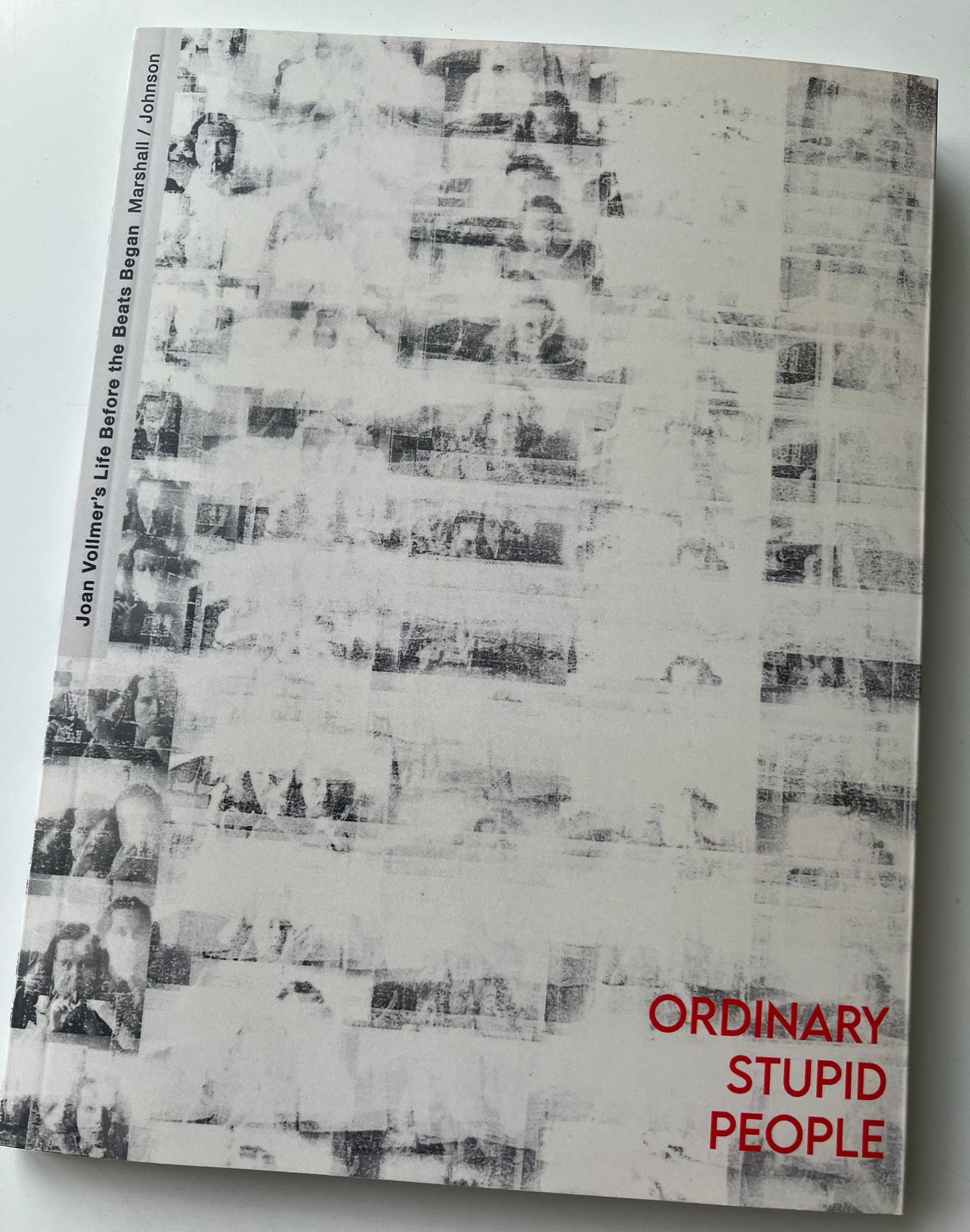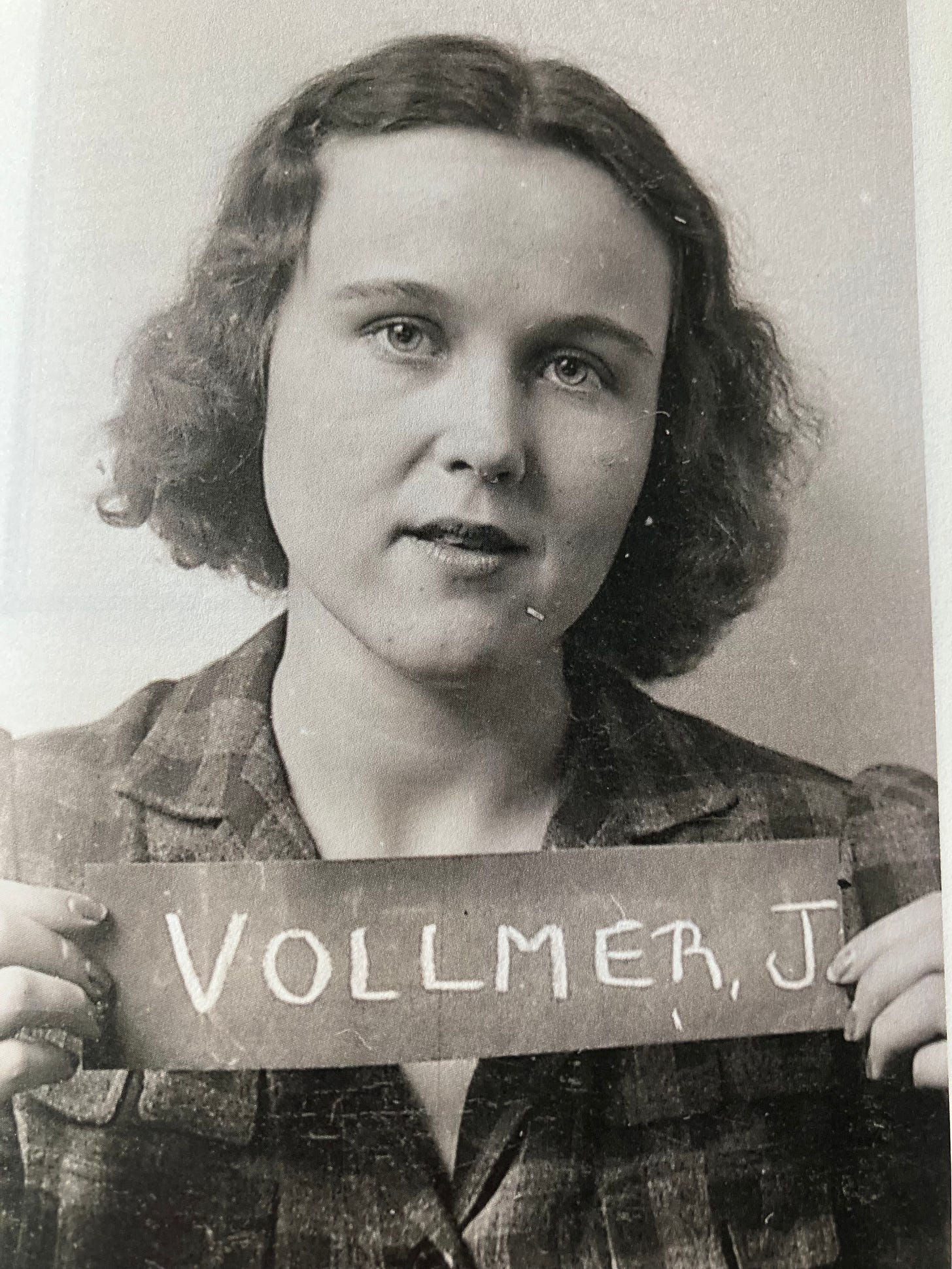Ordinary Stupid People by Catherine C. Marshall and Simon R. Johnson (Moloko Print, 2024)
A RECENT addition to the expanding bookshelf of Beat life stories is mere sliver of a biography. But the light released through the vent scored across the flesh of time is intense and revealing. And, for anyone with more than a passing interest in the evolution of this writing community, a book about a fringe player is always a fascinating addendum to fill gaps, even change minds, alter narratives.
Yet I call Joan Vollmer a figure at the margins when, of course, her death has become one of the most significant, not to say explosive, episodes in the tangled canon of Beat history, one that rivals the murder of David Kammerer, the first reading of ‘Howl’ or the New York Times review of Kerouac’s reputation-forging novel as towering signposts on the road to understanding this movement’s mid-century rise.
We need, I think, no spoiler alert that Vollmer would meet her end in 1951 in a Mexico City bar in the most chaotic of drunken situations when her common-law husband of some years William S. Burroughs ill-advisedly, some might propose recklessly, attempted to shoot a glass off his lover’s head and instead struck her in the temple. That saloon report concluded the brief existence of this 28 year old mother of two and already three times a wife.
But let us step back from that desperate, chilling moment and return to the principal subject matter of Ordinary Stupid People, the years from our subject’s birth in Loudonville, NY, in 1923 to the period two decades later when Vollmer befriended another young woman called Edie Parker and, both drawn to city life, they set up an apartment together in the Upper West Side of Manhattan.
The fact that these premises would become a meeting place for the Beats-to-be – Kerouac, Ginsberg and Burroughs – adds spice to the potion because here took root a feverish salon of radical ideas, nightlong discussions, drug experiments and sexual antics, providing the ‘New Vision’ rebels with a place to incubate their art, cultivate the madness.
Yet we have to regress still further in OSP, a collaborative project between researcher Catherine C. Marshall and archivist Simon R. Johnson, to discover that Vollmer had a relatively conventional early life, was an academic achiever and by the tender age of 16 was headed to New York City and the prestigious women’s institution Barnard College, a sister school to Columbia University.
It was really shortly afterwards that a stable canter through young life’s hurdles came to an end. Although she had won an impressive $500 scholarship, Vollmer decided to quit her educational digs with a fleeting romantic relationship to pursue.
In summary, there were various entanglements, not to mention marriages and a child to negotiate, yet it is only when the domestic setup with the soon-to-be Mrs Jack Kerouac transpires that she feels she has assumed the vibrant yet also dark, somewhat risky and risqué, life she had hoped the metropolis would grant her.
The wartime world she inhabits is unpredictable, volatile, exciting – lovers come and go, soldiers visit and then head to an uncertain future, Kerouac and others couch surf. There is there is an edge-of-the-apocalypse atmosphere meshed with the virile intentions of a transient crowd. Existentialism is an easy choice.
Pictured above: Joan Vollmer in an image sometimes mistakenly identified as a police mugshot. It is in fact a matriculation photograph at Barnard College, 1939
Yet there is no outstanding evidence that Vollmer – whose personality is a pale, rather insipid, affair contrasting with the outgoing flare of Edie – is really the intellectual powerhouse fuelling the conversations or ambitions of the men who would soon become the Beat giants with a disruptive cultural manifesto in mind.
In essence, Vollmer’s course seems careless and short of motivation and her quickening reliance on narcotics – primarily Benzedrine – begins to affect her physical health and mental psychology.
Because we do know what happens, the stories of OSP are cast in a long, retrospective shadow: it is hard to tease out the sunshine in this once promising student and 20-year-old party host whose chemical intake is already touching the limits before, in 1946, a relationship with Burroughs, who dubs her previous marital partners as ‘ordinary stupid people’, becomes a commitment, an association which leads to another child.
She does, of course, make a tantalising appearance in Oliver Harris’ true life detective mystery One Shot, in which he strives to pin down the meta details behind the most famous picture of the main Beat triumvirate taken around the time that twilight crew, those ships in the night, were filling the Parker/Vollmer home with the cacophony of chatter and music, literary concepts, strong liquor and illegal simulants.
As for the longer tragic arc of Vollmer’s horribly abbreviated tale, we will have to wait for Cathy Marshall, one of these joint authors, to produce her full account, ten years in preparation, of the woman’s unpredictable life and heartbreaking demise. That bigger picture, I’m pleased to say, is in progress, and Ordinary Stupid People – at 58 pages a quick, if enticing, read, with the bonus of 20 pages of supporting images – is merely an hors d’oeuvre to the main dish to come.






A fascinating read but I have two major problems with it.
How come her second husband who was in the book trade for many years, even telling people on occasion how he was once married to the lady killed by that famous writer William Burroughs, never had any letters to share or even when Burroughs was at his most famous made no effort to tell his story ?
Also: not enough is made of the persistent damage polio can do ... especially back then when treatment was minimal and only symptomatic. A life of dull pain and shy-making hobbling must leave its mark on character, behaviour and metabolism.
Vol et a revelation- the mad streets of Manhattan with Angel headed hipsters Beat poets and down on the scene before it was flooded with wanna bes and poseurs who lost the plot a revelation. The Village and the dusty streets of the lower east Side the streets vibrated to a jazz soundtrack.